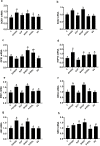Effects of phytogenic additives on meat quality traits in broiler chickens1
- PMID: 30184154
- PMCID: PMC6127791
- DOI: 10.1093/jas/sky238
Effects of phytogenic additives on meat quality traits in broiler chickens1
Abstract
Phytogenics have been reported to improve growth performances in farm animals and are thereby considered as potential key solutions for antibiotic-free livestock nutrition. Yet, their effects on meat quality are still not well defined; therefore, the aim of this study was to determine the effects of 5 experimental phytogenic additives (3 dietary and 2 water supplements) on growth and meat quality in broilers. One-day-old broiler chicks (n = 576) were assigned to 48 floor pens and divided into 6 treatments (Control, AV/HGP/16 premix [AVHGP], Superliv concentrate premix [SCP], bacteriostatic herbal growth promotor [BHGP], AV/SSL/12 [AVSSL], and Superliv Gold [SG]) in a complete randomized design (8 pens/treatment with 12 birds/pen, and 96 birds/group). Feed intake and BW were recorded, and birds were processed at 42 d to evaluate carcass traits. Breast muscle tissues were excised to determine stress- and antioxidant-related genes expression. Both AVSSL- and SG-treated broilers produced heavier (P < 0.05) slaughter weights compared with the control-fed broilers, whereas AVSSL supplementation decreased (P < 0.05) fat pad size and increased (P < 0.05) breast weights compared with the control-fed broilers. Although pH and a* values remained unchanged, L* was decreased (P < 0.05) in all treatment and b* was reduced (P < 0.05) in SG when compared with controls. The trained sensory panelists detected more (P < 0.05) green herb flavor in the breast meat from AVHGP than SCP, SG, and control birds. The expression of superoxide dismutase 2, extracellular signal-regulated kinase 1/2, and JNK gene was upregulated in AVHGP and BHGP compared with the control (P < 0.05). Together, these results indicated that phytogenic additives might improve meat quality of broilers through modulation of stress- and antioxidant-related pathways.
Keywords: antioxidation; gene expression; meat quality; phytogenics; sensory.
© The Author(s) 2018. Published by Oxford University Press on behalf of the American Society of Animal Science. All rights reserved. For permissions, please e-mail: journals.permissions@oup.com.
Figures


Similar articles
-
Phytogenic Water Additives Improve Broiler Growth Performance via Modulation of Intermediary Metabolism-Related Signaling Pathways.Animals (Basel). 2021 Mar 9;11(3):750. doi: 10.3390/ani11030750. Animals (Basel). 2021. PMID: 33803312 Free PMC article.
-
Phytogenic feed- and water-additives improve feed efficiency in broilers via modulation of (an)orexigenic hypothalamic neuropeptide expression.Neuropeptides. 2020 Jun;81:102005. doi: 10.1016/j.npep.2020.102005. Epub 2020 Jan 3. Neuropeptides. 2020. PMID: 31926603
-
Phytogenic feed additives improve broiler feed efficiency via modulation of intermediary lipid and protein metabolism-related signaling pathways.Poult Sci. 2021 Mar;100(3):100963. doi: 10.1016/j.psj.2020.12.060. Epub 2020 Dec 25. Poult Sci. 2021. PMID: 33652544 Free PMC article.
-
Regulating appetite in broilers for improving body and muscle development - A review.J Anim Physiol Anim Nutr (Berl). 2020 Nov;104(6):1819-1834. doi: 10.1111/jpn.13407. Epub 2020 Jun 26. J Anim Physiol Anim Nutr (Berl). 2020. PMID: 32592266 Free PMC article. Review.
-
The role of phytogenic feed additives in stress mitigation in broiler chickens.J Anim Physiol Anim Nutr (Berl). 2024 Jan;108(1):81-98. doi: 10.1111/jpn.13869. Epub 2023 Aug 16. J Anim Physiol Anim Nutr (Berl). 2024. PMID: 37587717 Review.
Cited by
-
Water amino acid-chelated trace mineral supplementation decreases circulating and intestinal HSP70 and proinflammatory cytokine gene expression in heat-stressed broiler chickens.J Anim Sci. 2020 Mar 1;98(3):skaa049. doi: 10.1093/jas/skaa049. J Anim Sci. 2020. PMID: 32047923 Free PMC article.
-
Impact of Phytase Supplementation on Meat Quality of Heat-Stressed Broilers.Animals (Basel). 2023 Jun 20;13(12):2043. doi: 10.3390/ani13122043. Animals (Basel). 2023. PMID: 37370553 Free PMC article.
-
Effects of Phytogenic Feed Additive on Production Performance, Slaughtering Performance, Meat Quality, and Intestinal Flora of White-Feathered Broilers.Vet Sci. 2025 Apr 22;12(5):396. doi: 10.3390/vetsci12050396. Vet Sci. 2025. PMID: 40431489 Free PMC article.
-
Phytogenic Water Additives Improve Broiler Growth Performance via Modulation of Intermediary Metabolism-Related Signaling Pathways.Animals (Basel). 2021 Mar 9;11(3):750. doi: 10.3390/ani11030750. Animals (Basel). 2021. PMID: 33803312 Free PMC article.
-
Phytogenic feed additives as natural antibiotic alternatives in animal health and production: A review of the literature of the last decade.Anim Nutr. 2024 Mar 22;17:244-264. doi: 10.1016/j.aninu.2024.01.012. eCollection 2024 Jun. Anim Nutr. 2024. PMID: 38800730 Free PMC article. Review.
References
-
- Amitav B., Adarsh C., Shivi M., and Ravikanth K.. 2015. Effect of supplementation of superliv liquid on the performance of commercial broilers in salimpur poultry farm of Mathura. Int. J. Adv. Res. 3:539–543.
-
- Amitav B., Satish K. G., Vinold K., Debashish R. K., and Shivi M.. 2013. Effects of superliv concentrate on the growth, immunocompetence traits and nutrient retention of commercial broilers during extreme winter. Int. J. Poult. Sci. 12: 51–54.
-
- Bazargani-Gilani B., Tajik H., and Aliakbarlu J.. 2014. Physicochemical and antioxidative characteristics of Iranian pomegranate (Punica granatum L. Cv. Rabbab-e-neyriz) juice and comparison of its antioxidative activity with zataria multiflora boiss essential oil. Vet. Res. Forum 5:313–318. - PMC - PubMed
-
- Cavitt L., Youm G., Meullenet J., Owens C., and Xiong R.. 2004. Prediction of poultry meat tenderness using razor blade shear, Allo‐Kramer shear, and sarcomere length. J. Food Sci. 69:SNQ11–SNQ15.
MeSH terms
Substances
LinkOut - more resources
Full Text Sources
Other Literature Sources
Research Materials

